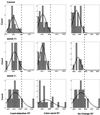Attention deficit/hyperactivity disorder children with a 7-repeat allele of the dopamine receptor D4 gene have extreme behavior but normal performance on critical neuropsychological tests of attention
- PMID: 10781080
- PMCID: PMC18305
- DOI: 10.1073/pnas.080070897
Attention deficit/hyperactivity disorder children with a 7-repeat allele of the dopamine receptor D4 gene have extreme behavior but normal performance on critical neuropsychological tests of attention
Abstract
An association of the dopamine receptor D4 (DRD4) gene located on chromosome 11p15.5 and attention deficit/hyperactivity disorder (ADHD) has been demonstrated and replicated by multiple investigators. A specific allele [the 7-repeat of a 48-bp variable number of tandem repeats (VNTR) in exon 3] has been proposed as an etiological factor in attentional deficits manifested in some children diagnosed with this disorder. In the current study, we evaluated ADHD subgroups defined by the presence or absence of the 7-repeat allele of the DRD4 gene, using neuropsychological tests with reaction time measures designed to probe attentional networks with neuroanatomical foci in D4-rich brain regions. Despite the same severity of symptoms on parent and teacher ratings for the ADHD subgroups, the average reaction times of the 7-present subgroup showed normal speed and variability of response whereas the average reaction times of the 7-absent subgroup showed the expected abnormalities (slow and variable responses). This was opposite the primary prediction of the study. The 7-present subgroup seemed to be free of some of the neuropsychological abnormalities thought to characterize ADHD.
Figures
References
-
- Posner M I, Raichle M E. Images of Mind. New York: Sci. Am. Library; 1994.
-
- Barkley R A. Sci Am. 1998;279:66–71. - PubMed
-
- Swanson J M, Flodman P, Kennedy J, Spence M A, Moyzis R, Schuck S, Murias M, Moriarity J, Barr C, Smith M, Posner M. Neurosci Biobehav Rev. 2000;24:21–25. - PubMed
-
- Civelli O, Bunzow J R, Grandy D K, Zhou Q, Hubert H M. Eur J Pharmacol Mol Pharmacol Sect. 1991;207:277–286. - PubMed
MeSH terms
Substances
LinkOut - more resources
Full Text Sources
Other Literature Sources
Medical



